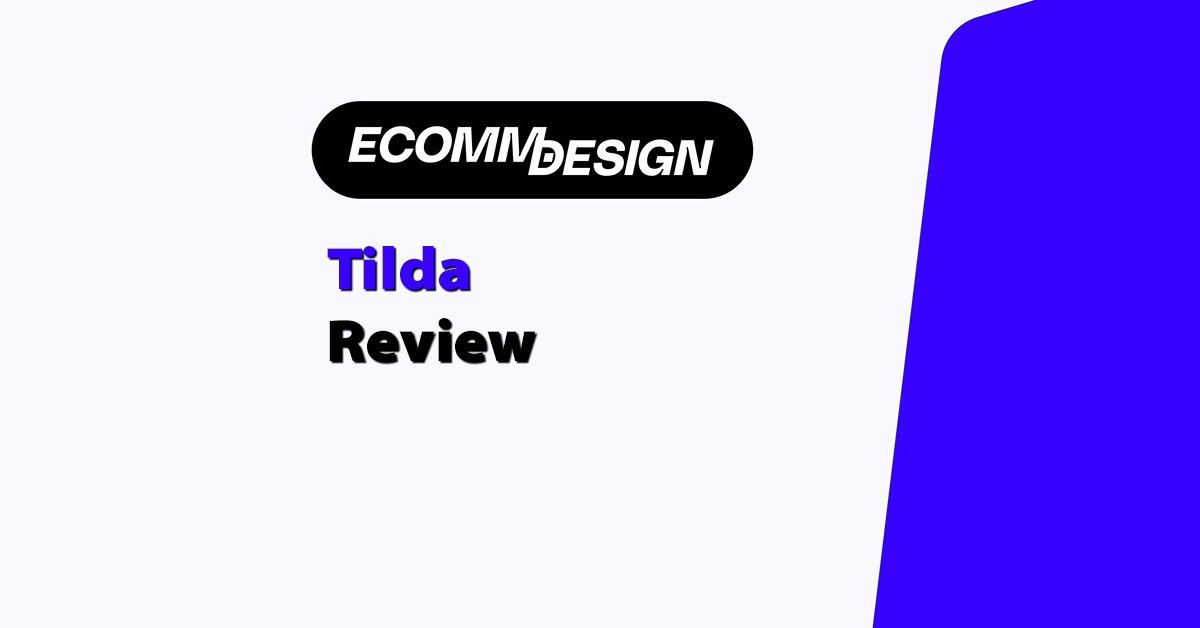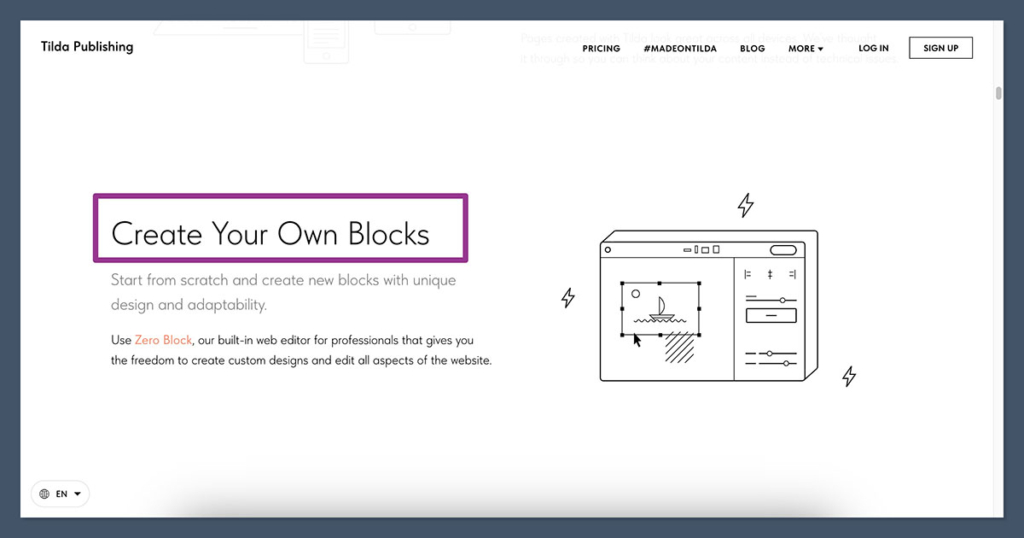
Tilda is my top rated design-first ecommerce builder. It blends a totally visual editor called Zero Block with clear selling tools like multichannel product sync, card based checkout, and native A B testing.
That mix gives small stores and digital sellers a rare balance: pixel level control without a steep code climb.
My team and I have built and tested stores on twelve other platforms this year.
After more than three hundred hours of hands-on trials, speed audits, and live sales runs, I can say with confidence that Tilda sits at the front if you care about brand look and quick launch.
In this review I break down Tilda pricing, features, and templates so you can see exactly why it ranked so high in our latest research.
Why you can trust this review
We run structured tests on each builder every twelve months. That means fresh data for load time, SEO settings, conversion tools, and real sales volume.
The process is independent, repeatable, and numbers driven, giving you a clear picture before you commit.
Tilda at a Glance
| Best for | Design-led stores |
| Rating | 4.4 / 5 |
| Free trial / Free plan | Yes |
| Paid plans (US) | $15 – $30 per month (monthly) $12 – $25 per month (annual) |
| Pros | • Multichannel product sync (Facebook, Google Shopping, Instagram) • Zero Block editor for true custom layouts • Built-in A/B testing and analytics hooks |
| Cons | • Lacks deep inventory rules • Checkout is not fully custom • Limited native tax settings |
What I like
- Unlimited visual freedom with drag and drop positions, custom fonts, and responsive tweaks
- Fast page speed when images are compressed, often scoring 85 + on PageSpeed Insights
- A B testing baked in, no external script needed
- Forms, popups, and lead capture blocks ready to drop in
What I dislike
- Needs extra code to add full product schema
- Few third party add-ons compared with Shopify or WordPress
- Payment options are solid but not exhaustive
- Only one true ecommerce template set, so expect manual tweaks
My first hand setup experience
Signing up asked only for an email. After that Tilda walked me through three short prompts:
- Where do you want to sell? (online store, social media, or both)
- Business stage (new idea or existing sales)
- First item type (physical, digital, service)
No credit card, no friction. Ten minutes later the first product page was live on a temporary subdomain and ready for test orders.
Tilda’s Interface: Clean, But Not For Everyone

One thing Tilda nails is its user interface. Everything feels clean, minimal, and intuitive.
You start with a library of pre-built blocks — headers, forms, product galleries, CTAs, testimonials — and drag them into place.
But here’s where it gets interesting: Zero Block.
Zero Block is their custom design editor.
Think of it like Canva meets Figma, but for web pages. You can position elements however you want, down to the pixel.
Verdict:
If you care about design freedom, Tilda wins. But if you want plug-and-play, you might find it fiddly.
Ecommerce Features: Decent for Small Stores
Tilda isn’t trying to be Shopify — and it shows.
The ecommerce functionality is there, but it’s not very deep. You can sell physical or digital products, track orders, and accept payments via Stripe or PayPal.
That’s enough for a small ecommerce business, solo founder, or someone selling a few SKUs.
But once you scale, it hits limits fast.
What You Get:
- Basic product catalogue
- Shopping cart and checkout
- Inventory tracking (minimal)
- Email notifications
- CRM features (basic)
- Connect Stripe, PayPal, or Tinkoff
What’s Missing:
- No advanced inventory management
- Limited third-party app integrations
- No built-in email marketing automation
- Weak tax settings for international sales
Verdict:
Fine for micro stores or digital goods. Not built for serious ecommerce at scale. Think Etsy-level, not Amazon-level.
SEO Tools: Solid, But Not Perfect
Most no-code builders are SEO nightmares. Bloated code, locked-in URLs, slow page speed. Tilda avoids a lot of that — but it still has room to improve.
I ran some test pages through Google PageSpeed Insights. If you keep animations and media light, you’ll hit 85+ easily. But it drops fast when you add complex visuals.
What Works:
- Customisable meta titles and descriptions
- Header structure is editable (H1, H2, etc.)
- Pages load fast (if optimised)
- Auto-generated sitemap.xml and robots.txt
- Connects with Google Analytics and Search Console
Limitations:
- No control over structured data/schema
- Hard to add custom JSON-LD
- No built-in schema for ecommerce
- Can’t fine-tune URL structure as much as WordPress or Webflow
Verdict:
It’s better than Wix, but not as flexible as WordPress or Webflow. If SEO is your #1 priority, Tilda needs support from custom workarounds.
Conversion-Focused Features: Where Tilda Shines
This is where I was impressed.
Tilda makes it easy to design landing pages that convert. The visual design system encourages minimal layouts with strong CTAs. It’s basically built with lead-gen and ecommerce storytelling in mind.
Features That Help Boost Conversions:
- Built-in A/B testing
- Animations and micro-interactions without code
- Integrated lead forms and popups
- Pre-made blocks for testimonials, FAQs, guarantees
- Clean mobile performance
- Analytics integrations (GA4, Facebook Pixel, Hotjar)
I ran a few landing pages through Facebook ads to cold traffic. Tilda’s pages converted just as well — sometimes better — than my Webflow builds.
Likely because the process was quicker and easier to test layouts fast.
Verdict:
If you need beautiful, high-converting landing pages fast, Tilda delivers. The A/B testing and layout flexibility are gold.
Mobile Optimization: Surprisingly Good
Let’s face it: mobile performance can make or break your ecommerce site. I was ready to see laggy mobile design, but Tilda surprised me.
Their block-based system is fully responsive.
Even custom-built pages in Zero Block adjust cleanly to mobile, though you’ll still need to test manually.
Mobile Design Highlights:
- Mobile-first approach in templates
- Responsive animations
- Fast load times on 4G
- Separate mobile editing in Zero Block
- Lazy loading images by default
The ability to fine-tune spacing and element placement for mobile is a huge win.
Verdict:
Mobile UX is way better than other builders in this space. You’ll still want to preview often, but the foundation is solid.
Custom Code and Integrations: Flexible Enough

Tilda keeps the no-code label but also allows power users to add custom scripts and integrations. This is great if you’re trying to patch its weaker SEO or analytics setup.
What You Can Add:
- HTML blocks for embeds
- Custom CSS and JavaScript
- Third-party plugins via header/footer injections
- Webhooks
- Zapier, Telegram, Mailchimp, and more
It’s not as developer-friendly as Webflow, but it’s more flexible than Wix or Squarespace.
Verdict:
There’s enough room to grow if you know your way around custom code. But you’ll still hit limits if your tech stack gets complex.
Tilda vs Competitors: Quick Comparison Table
| Feature | Tilda | Webflow | Shopify | Wix |
|---|---|---|---|---|
| Design Freedom | ✅✅✅ | ✅✅✅ | ❌ | ✅ |
| Ecommerce Strength | ✅ | ✅✅ | ✅✅✅ | ✅ |
| SEO Control | ✅✅ | ✅✅✅ | ✅ | ❌ |
| Mobile Optimisation | ✅✅✅ | ✅✅✅ | ✅✅ | ✅ |
| Learning Curve | Medium | High | Low | Low |
| Conversions | ✅✅✅ | ✅✅ | ✅✅ | ✅ |
| Pricing | £10-£25/mo | £14-£35/mo | £25-£250/mo | £8-£30/mo |
Who Is Tilda Best For?
Here’s who I’d recommend Tilda for:
- Designers who want control without diving into code
- Ecommerce beginners who sell a few products or digital goods
- Landing page creators focused on conversions
- Freelancers or solo founders wanting quick setup and pro results
Who should skip it?
- Big ecommerce brands
- Anyone needing deep backend features or ERP sync
- Teams with complex multi-language or multi-location needs
Final Verdict: Should You Use Tilda for Ecommerce Design?
Yes — but only if your goals are aligned. Tilda is a niche tool, not a mass-market builder. It shines for:
- Beautiful, high-converting ecommerce pages
- Unique design control
- Lightweight SEO efforts
- Speed and simplicity
But if you’re building a full ecommerce operation with complex logistics, it will eventually hold you back.
My recommendation:
Use Tilda to test product ideas, build landing pages, or launch digital goods. Then, if you scale, move to something like Shopify or Webflow for long-term growth.






